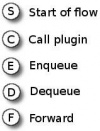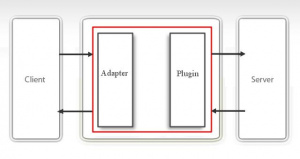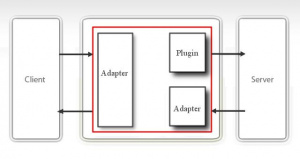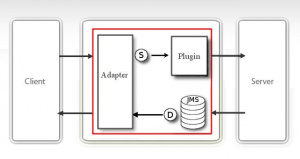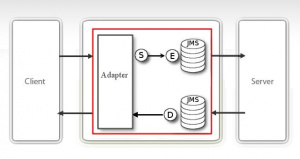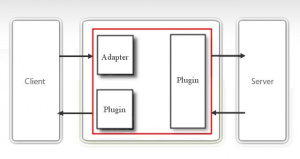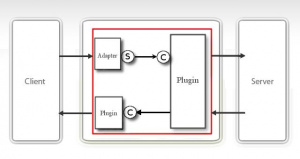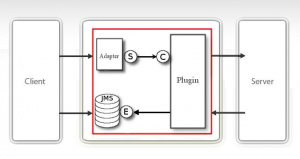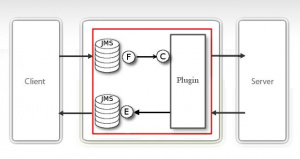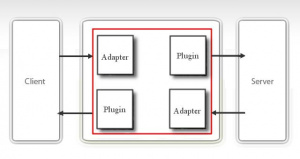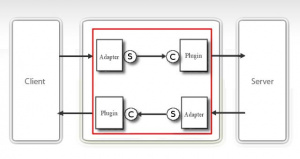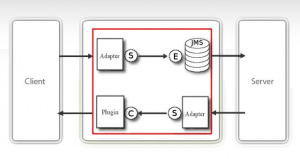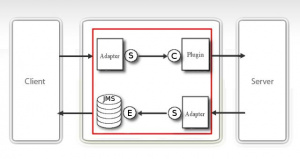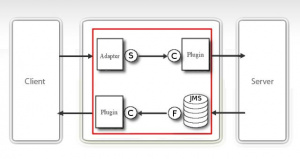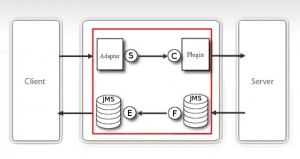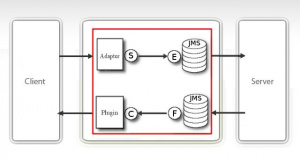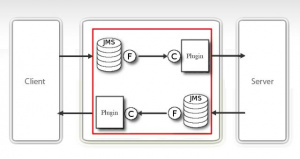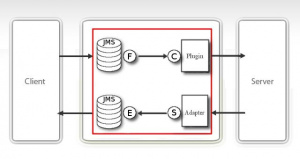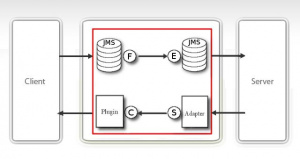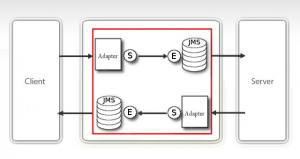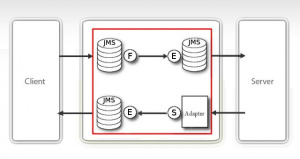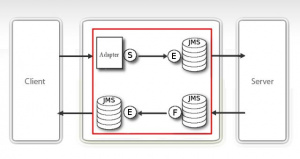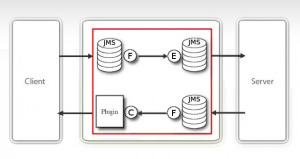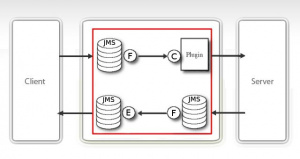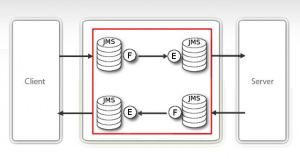Difference between revisions of "Paradigms of communication"
(→Synchronous-Asynchronous) |
(→Synchronous-Asynchronous) |
||
| (17 intermediate revisions by the same user not shown) | |||
| Line 3: | Line 3: | ||
Depending on the type of communication (Synchronous / Asynchronous), on the role played by {{GVESB}} (active / passive) and on the response management, it is possible to have from a minimum of one to a maximum of four operations constituting a single interaction client - server. | Depending on the type of communication (Synchronous / Asynchronous), on the role played by {{GVESB}} (active / passive) and on the response management, it is possible to have from a minimum of one to a maximum of four operations constituting a single interaction client - server. | ||
| + | =={{GVESB}} Configuration== | ||
| + | |||
| + | [[File:Paradigm.jpg|thumb|100px|Legend]]{{GVESB}} is configured for managing four paradigms of communication: | ||
| − | |||
| − | |||
*[[Paradigms_of_communication#Synchronous-Synchronous|Synchronous - Synchronous]] | *[[Paradigms_of_communication#Synchronous-Synchronous|Synchronous - Synchronous]] | ||
*[[Paradigms_of_communication#Synchronous-Asynchronous|Synchronous - Asynchronous]] | *[[Paradigms_of_communication#Synchronous-Asynchronous|Synchronous - Asynchronous]] | ||
*[[Paradigms_of_communication#Asynchronous-Synchronous|Asynchronous - Synchronous ]] | *[[Paradigms_of_communication#Asynchronous-Synchronous|Asynchronous - Synchronous ]] | ||
*[[Paradigms_of_communication#Asynchronous-Asynchronous|Asynchronous - Asynchronous]] | *[[Paradigms_of_communication#Asynchronous-Asynchronous|Asynchronous - Asynchronous]] | ||
| + | |||
| + | |||
| + | These paradigms are explained bellow. The figure shows the legend used. | ||
===Synchronous-Synchronous=== | ===Synchronous-Synchronous=== | ||
| − | [[File:ParadigmSS.jpg|thumb|Synchronous-Synchronous]]The Synchronous-Synchronous | + | [[File:ParadigmSS.jpg|thumb|Synchronous-Synchronous]] |
| + | |||
| + | |||
| + | The following table shows the properties of the Synchronous-Synchronous communication: | ||
| − | |||
{|class="gvtable" | {|class="gvtable" | ||
! !! Client !! GVESB Workflow Number !! Server | ! !! Client !! GVESB Workflow Number !! Server | ||
| Line 26: | Line 32: | ||
===Synchronous-Asynchronous=== | ===Synchronous-Asynchronous=== | ||
| − | [[File:ParadigmSA.jpg|thumb|Synchronous-Asynchronous]]The Synchronous-Asynchronous | + | [[File:ParadigmSA.jpg|thumb|Synchronous-Asynchronous]] |
| + | |||
| + | |||
| + | The following table shows the properties of the Synchronous-Asynchronous communication: | ||
| − | |||
{|class="gvtable" | {|class="gvtable" | ||
! !! Client !! GVESB Workflow Number !! Server | ! !! Client !! GVESB Workflow Number !! Server | ||
|- | |- | ||
| − | | Communication || Synchronous || 1 || | + | | Communication || Synchronous || 1 || Asynchronous |
|} | |} | ||
| + | |||
| + | The decoupling of communication can happen in two ways: | ||
| + | # {{GVESB}}, using a [[Plugins|plugin]], invokes the server and waits for the response into a queue jms, bmq, etc. [[File:ParadigmSA1.jpg|none|thumb|plugin->server->jms]] | ||
| + | # {{GVESB}} enqueues into a jms queue shared with server and waits for the response into another jms queue.[[File:ParadigmSA2.jpg|none|thumb|jms->server->jms]] | ||
===Asynchronous-Synchronous=== | ===Asynchronous-Synchronous=== | ||
| + | [[File:ParadigmAS.jpg|thumb|Asynchronous-Synchronous]] | ||
| + | |||
| + | |||
| + | The following table shows the properties of the Asynchronous-Synchronous communication: | ||
| + | {|class="gvtable" | ||
| + | ! !! Client !! GVESB Workflow Number !! Server | ||
| + | |- | ||
| + | | Communication || Asynchronous || 2/3 || Synchronous | ||
| + | |} | ||
| + | |||
| + | The decoupling of communication might happen in three ways: | ||
| + | # The Client makes a request to {{GVESB}} using an Adapter. {{GVESB}} elaborates the request, and after eventually communication with others systems, invokes a Service into the Client system to communicate the response. [[File:ParadigmAS3.jpg|none|thumb|Adapter->plugin->server->plugin]] | ||
| + | # The Client makes a Request to {{GVESB}} using an Adapter. {{GVESB}} elaborates the request, and after eventually communication with others systems, enqueues the response in a queue shared with Client.[[File:ParadigmAS1.jpg|none|thumb|Adapter->plugin->server->jms]] | ||
| + | # The Client enqueue a message, {{GVESB}} dequeue it, an after eventually communication with others systems, enqueues the response in a queue shared with Client.[[File:ParadigmAS2.jpg|none|thumb|jms->plugin->server->jms]] | ||
===Asynchronous-Asynchronous=== | ===Asynchronous-Asynchronous=== | ||
| + | |||
| + | [[File:ParadigmAA.jpg|thumb|Asynchronous-Asynchronous]] | ||
| + | |||
| + | |||
| + | The following table shows the properties of the Asynchronous-Asynchronous communication: | ||
| + | |||
| + | {|class="gvtable" | ||
| + | ! !! Client !! GVESB Workflow Number !! Server | ||
| + | |- | ||
| + | | Communication || Asynchronous || 4 || Asynchronous | ||
| + | |} | ||
| + | |||
| + | The decoupling of communication might happen in sixteen ways: | ||
| + | # The Client sends a Request to {{GVESB}} through an adapter, {{GVESB}} sends it to the Server. The server elaborates the request and, using an adapter, sends the response to the Client (SendReply).[[File:ParadigmAA1.jpg|none|thumb|Adapter->Plugin->server->Adapter->Plugin]] | ||
| + | # The Client sends a Request to {{GVESB}} through an adapter, {{GVESB}} enqueues into a Server JMS queue. The server elaborates the request and, using an adapter, sends the response to the Client (SendReply).[[File:ParadigmAA2.jpg|none|thumb|Adapter->JMS->server->Adapter->Plugin]] | ||
| + | # The Client sends a Request to {{GVESB}} through an adapter, {{GVESB}} enqueues into a Server JMS queue. The server elaborates the request and, using an adapter, sends the response to the Client who enqueue it in a Client JMS queue (SendReply).[[File:ParadigmAA3.jpg|none|thumb|Adapter->Plugin->server->Adapter->JMS]] | ||
| + | # The Client sends a Request to {{GVESB}} through an adapter, {{GVESB}} sends to the Server. The server elaborates the request and, using an adapter, sends the response to {{GVESB}} who enqueue it in a Client JMS queue (SendReply).[[File:ParadigmAA4.jpg|none|thumb|Adapter->Plugin->server->JMS->Plugin]] | ||
| + | # The Client sends a Request to {{GVESB}} through an adapter, {{GVESB}} sends to the Server. The server elaborates the request and enqueues it into a {{GVESB}} queue which, through a Forward, sends the response to a Client JMS queue.[[File:ParadigmAA5.jpg|none|thumb|Adapter->Plugin->server->JMS->JMS]] | ||
| + | # The Client sends a Request to {{GVESB}} through an adapter, {{GVESB}} enqueues into a Server JMS queue. The server elaborates the request and enqueues it into a {{GVESB}} queue which, through a Forward, sends the response to the Client.[[File:ParadigmAA6.jpg|none|thumb|Adapter->JMS->server->JMS->Plugin]] | ||
| + | # The Client sends a Request to {{GVESB}} through an adapter, {{GVESB}} enqueues into a Server JMS queue from which a Forward sends it to the Server. The server elaborates the request and enqueues it into a {{GVESB}} JMS queue which, through a Forward, sends the response to the Client.[[File:ParadigmAA7.jpg|none|thumb|JMS->Plugin->server->JMS->Plugin]] | ||
| + | # The Client sends a Request to {{GVESB}} through an adapter, {{GVESB}} enqueues into a Server JMS queue from which a Forward sends it to the Server. The server elaborates the request and through an Adapter sends it to {{GVESB}} (SendReply) which enquues into a Client JMS queue.[[File:ParadigmAA8.jpg|none|thumb|JMS->Plugin->server->Adapter->JMS]] | ||
| + | # The Client sends a Request, using an Adapter, to {{GVESB}} who enqueues it into a JMS queue, and with a Forward sends it to the Server. The server elaborates the request and through an Adapter sends it to {{GVESB}} (SendReply).[[File:ParadigmAA9.jpg|none|thumb|JMS->Plugin->server->Adapter->Plugin]] | ||
| + | # The Client sends a Request, using an Adapter, to {{GVESB}} who enqueues it into a JMS queue from which a Forward enqueues into a Server JMS queue. The server elaborates the request and through an Adapter sends it to {{GVESB}} (SendReply).[[File:ParadigmAA10.jpg|none|thumb|JMS->JMS->server->Adapter->Plugin]] | ||
| + | # The Client sends a Request, using an Adapter, to {{GVESB}} who enqueues it into a Server JMS queue. The server elaborates the request and through an Adapter sends it to {{GVESB}} (SendReply) which enqueues it into a Client JMS queue.[[File:ParadigmAA11.jpg|none|thumb|Adapter->JMS->server->Adapter->JMS]] | ||
| + | # The Client sends a Request, using an Adapter, to {{GVESB}} who enqueues it and successively a Forward enqueues it into a Server JMS queue. The server elaborates the request and through an Adapter sends it to {{GVESB}} (SendReply) which enqueues it into a Client JMS queue.[[File:ParadigmAA12.jpg|none|thumb|JMS->JMS->server->Adapter->JMS]] | ||
| + | # The Client sends a Request, using an Adapter. {{GVESB}} enqueues it into a Server JMS queue. The server elaborates the request and enqueues the response into a {{GVESB}} JMS queue which, using a Forward, enqueues it into a Client JMS queue.[[File:ParadigmAA13.jpg|none|thumb|Adapter->JMS->server->JMS->JMS]] | ||
| + | # The Client sends a Request, using an Adapter. {{GVESB}} enqueues and successively a Forward enqueues it into a Server JMS queue. The server elaborates the request and enqueues the response into a {{GVESB}} JMS queue which, using a Forward, sends it to the Client.[[File:ParadigmAA14.jpg|none|thumb|JMS->JMS->server->JMS->Plugin]] | ||
| + | # The Client sends a Request, using an Adapter. {{GVESB}} enqueues and successively a Forward sends it the Server. The server elaborates the request and enqueues the response into a {{GVESB}} JMS queue which, using a Forward, enqueues it into a Client JMS queue.[[File:ParadigmAA15.jpg|none|thumb|JMS->Plugin->server->JMS->JMS]] | ||
| + | # The Client sends a Request, using an Adapter. {{GVESB}} enqueues and successively a Forward enqueues it into a Server JMS queue. The server elaborates the request and enqueues the response into a {{GVESB}} JMS queue which, using a Forward, enqueues it into a Client JMS queue.[[File:ParadigmAA16.jpg|none|thumb|JMS->JMS->server->JMS->JMS]] | ||
Latest revision as of 15:54, 11 February 2012
Contents
Description
Depending on the type of communication (Synchronous / Asynchronous), on the role played by GreenVulcano® ESB (active / passive) and on the response management, it is possible to have from a minimum of one to a maximum of four operations constituting a single interaction client - server.
GreenVulcano® ESB Configuration
GreenVulcano® ESB is configured for managing four paradigms of communication:
- Synchronous - Synchronous
- Synchronous - Asynchronous
- Asynchronous - Synchronous
- Asynchronous - Asynchronous
These paradigms are explained bellow. The figure shows the legend used.
Synchronous-Synchronous
The following table shows the properties of the Synchronous-Synchronous communication:
| Client | GVESB Workflow Number | Server | |
|---|---|---|---|
| Communication | Synchronous | 1 | Synchronous |
Synchronous-Asynchronous
The following table shows the properties of the Synchronous-Asynchronous communication:
| Client | GVESB Workflow Number | Server | |
|---|---|---|---|
| Communication | Synchronous | 1 | Asynchronous |
The decoupling of communication can happen in two ways:
- GreenVulcano® ESB, using a plugin, invokes the server and waits for the response into a queue jms, bmq, etc.
- GreenVulcano® ESB enqueues into a jms queue shared with server and waits for the response into another jms queue.
Asynchronous-Synchronous
The following table shows the properties of the Asynchronous-Synchronous communication:
| Client | GVESB Workflow Number | Server | |
|---|---|---|---|
| Communication | Asynchronous | 2/3 | Synchronous |
The decoupling of communication might happen in three ways:
- The Client makes a request to GreenVulcano® ESB using an Adapter. GreenVulcano® ESB elaborates the request, and after eventually communication with others systems, invokes a Service into the Client system to communicate the response.
- The Client makes a Request to GreenVulcano® ESB using an Adapter. GreenVulcano® ESB elaborates the request, and after eventually communication with others systems, enqueues the response in a queue shared with Client.
- The Client enqueue a message, GreenVulcano® ESB dequeue it, an after eventually communication with others systems, enqueues the response in a queue shared with Client.
Asynchronous-Asynchronous
The following table shows the properties of the Asynchronous-Asynchronous communication:
| Client | GVESB Workflow Number | Server | |
|---|---|---|---|
| Communication | Asynchronous | 4 | Asynchronous |
The decoupling of communication might happen in sixteen ways:
- The Client sends a Request to GreenVulcano® ESB through an adapter, GreenVulcano® ESB sends it to the Server. The server elaborates the request and, using an adapter, sends the response to the Client (SendReply).
- The Client sends a Request to GreenVulcano® ESB through an adapter, GreenVulcano® ESB enqueues into a Server JMS queue. The server elaborates the request and, using an adapter, sends the response to the Client (SendReply).
- The Client sends a Request to GreenVulcano® ESB through an adapter, GreenVulcano® ESB enqueues into a Server JMS queue. The server elaborates the request and, using an adapter, sends the response to the Client who enqueue it in a Client JMS queue (SendReply).
- The Client sends a Request to GreenVulcano® ESB through an adapter, GreenVulcano® ESB sends to the Server. The server elaborates the request and, using an adapter, sends the response to GreenVulcano® ESB who enqueue it in a Client JMS queue (SendReply).
- The Client sends a Request to GreenVulcano® ESB through an adapter, GreenVulcano® ESB sends to the Server. The server elaborates the request and enqueues it into a GreenVulcano® ESB queue which, through a Forward, sends the response to a Client JMS queue.
- The Client sends a Request to GreenVulcano® ESB through an adapter, GreenVulcano® ESB enqueues into a Server JMS queue. The server elaborates the request and enqueues it into a GreenVulcano® ESB queue which, through a Forward, sends the response to the Client.
- The Client sends a Request to GreenVulcano® ESB through an adapter, GreenVulcano® ESB enqueues into a Server JMS queue from which a Forward sends it to the Server. The server elaborates the request and enqueues it into a GreenVulcano® ESB JMS queue which, through a Forward, sends the response to the Client.
- The Client sends a Request to GreenVulcano® ESB through an adapter, GreenVulcano® ESB enqueues into a Server JMS queue from which a Forward sends it to the Server. The server elaborates the request and through an Adapter sends it to GreenVulcano® ESB (SendReply) which enquues into a Client JMS queue.
- The Client sends a Request, using an Adapter, to GreenVulcano® ESB who enqueues it into a JMS queue, and with a Forward sends it to the Server. The server elaborates the request and through an Adapter sends it to GreenVulcano® ESB (SendReply).
- The Client sends a Request, using an Adapter, to GreenVulcano® ESB who enqueues it into a JMS queue from which a Forward enqueues into a Server JMS queue. The server elaborates the request and through an Adapter sends it to GreenVulcano® ESB (SendReply).
- The Client sends a Request, using an Adapter, to GreenVulcano® ESB who enqueues it into a Server JMS queue. The server elaborates the request and through an Adapter sends it to GreenVulcano® ESB (SendReply) which enqueues it into a Client JMS queue.
- The Client sends a Request, using an Adapter, to GreenVulcano® ESB who enqueues it and successively a Forward enqueues it into a Server JMS queue. The server elaborates the request and through an Adapter sends it to GreenVulcano® ESB (SendReply) which enqueues it into a Client JMS queue.
- The Client sends a Request, using an Adapter. GreenVulcano® ESB enqueues it into a Server JMS queue. The server elaborates the request and enqueues the response into a GreenVulcano® ESB JMS queue which, using a Forward, enqueues it into a Client JMS queue.
- The Client sends a Request, using an Adapter. GreenVulcano® ESB enqueues and successively a Forward enqueues it into a Server JMS queue. The server elaborates the request and enqueues the response into a GreenVulcano® ESB JMS queue which, using a Forward, sends it to the Client.
- The Client sends a Request, using an Adapter. GreenVulcano® ESB enqueues and successively a Forward sends it the Server. The server elaborates the request and enqueues the response into a GreenVulcano® ESB JMS queue which, using a Forward, enqueues it into a Client JMS queue.
- The Client sends a Request, using an Adapter. GreenVulcano® ESB enqueues and successively a Forward enqueues it into a Server JMS queue. The server elaborates the request and enqueues the response into a GreenVulcano® ESB JMS queue which, using a Forward, enqueues it into a Client JMS queue.
